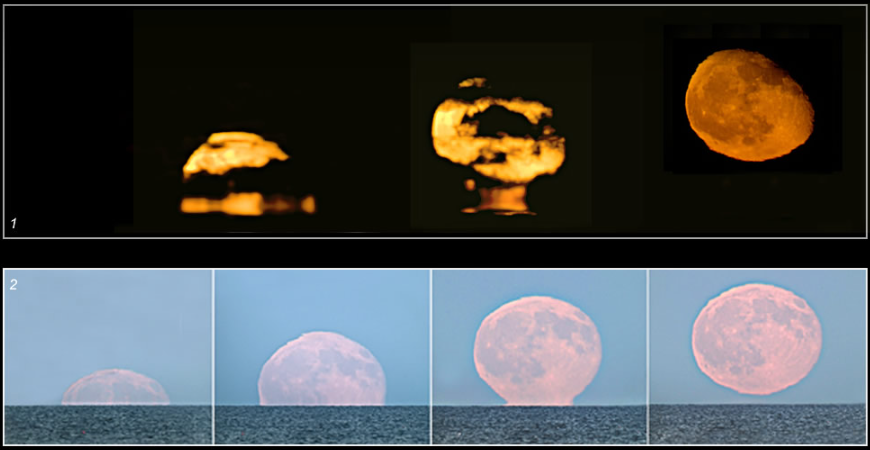OPOD - Maine Mirage Medley
OPOD - Maine Mirage Medley: A Fascinating Display of Atmospheric Optics
Maine is known for its stunning natural beauty, and sometimes the atmosphere puts on a show that is nothing short of magical. In this article, we delve into the captivating world of atmospheric optics, specifically focusing on the mesmerizing mirages captured by photographer John Stetson in his "Maine Mirage Medley." These mirages, also known as inferior mirages, showcase the intriguing phenomenon of light refraction and temperature gradients in the atmosphere.
Moonrise Marvels: Unveiling the Etruscan Vase
One of the most enchanting images captured by John Stetson is the moonrise over Casco Bay in Cape Elizabeth. As the moon ascends into the sky, passing clouds and unsteady air work their magic, transforming the moon's appearance into an ethereal Etruscan Vase shape. The interplay of temperature gradients in the atmosphere creates a mesmerizing display, with more notches appearing on the Moon's limb even when it is well clear of the horizon.
Unveiling the Distorted Horizon
In another captivating photograph, Stetson captures a distorted horizon during a moonrise in Casco Bay. The distortion near the horizon is already evident, showcasing the influence of atmospheric conditions on our perception of celestial objects. This distortion serves as a testament to the ever-changing nature of our atmosphere and its ability to shape our visual experiences.
Sebago Lake Mirage: Where Warm Meets Cold
Moving away from moonrises, Stetson also captures a remarkable mirage on Sebago Lake. This mirage is produced by refraction across temperature gradients between the warmer lake surface and the cooler air above. With the water temperature at 53°F and the air temperature some distance above it at only 32°F, the conditions are ideal for the creation of this captivating optical illusion.
The Illusion of Fragmented Water
In a close-up of the Sebago Lake mirage, Stetson reveals the seemingly rough and fragmented appearance of the water. However, this is purely an illusion created by the mirage's lower edge. The refraction of light passing through the varying temperature layers in the atmosphere causes the image to distort, giving the impression of fragmented water. It is a testament to the power of light and its ability to deceive our senses.
Exploring the Wonders of Atmospheric Optics
The "Maine Mirage Medley" captured by John Stetson offers us a glimpse into the captivating world of atmospheric optics. These mesmerizing mirages are a result of temperature gradients and light refraction, showcasing the ever-changing nature of our atmosphere and its impact on our visual perception. As we marvel at these optical illusions, we are reminded of the intricate interplay between light, temperature, and atmospheric conditions.
Conclusion: A Window into Nature's Artistry
The "Maine Mirage Medley" serves as a reminder of the awe-inspiring beauty that surrounds us and the wonders of atmospheric optics. Through the lens of John Stetson's camera, we witness the transformation of celestial objects and the creation of captivating optical illusions. These images invite us to appreciate the dynamic nature of our atmosphere and its ability to shape our visual experiences. So next time you find yourself gazing at the sky or a body of water, take a moment to observe the subtle interplay between light and temperature, for you never know what stunning display of atmospheric optics may unfold before your eyes.

Maine Mirages ~ Moonrise and terrestrial 'warm air beneath cold' mirages by John Stetson. It seems unfair to call such sights by their technical name - 'inferior mirages'. ©John Stetson, shown with permission.
1 - Moonrise over Casco Bay, Cape Elizabeth on November 24, 2010. Passing clouds and unsteady air further work and transform the Etruscan Vase shape. More temperature gradients notch the Moon's limb even as it is well clear of the horizon.
2 - Casco Bay moonrise October 23, 2010. The distortion near the horizon is already evident in the second image.

3 - Mirage on Sebago Lake also October 23. The water temperature was 53F and that of the air some distance above it only 32F. The mirage is produced by refraction across the temperature gradients between the lake warmed air and cooler air above.

4 - A close up of the Sebago Lake mirage shows the apparently rough and fragmented water. Purely an illusion at the mirage's lower edge.
Note: this article has been automatically converted from the old site and may not appear as intended. You can find the original article here.
Reference Atmospheric Optics
If you use any of the definitions, information, or data presented on Atmospheric Optics, please copy the link or reference below to properly credit us as the reference source. Thank you!
-
<a href="https://atoptics.co.uk/blog/opod-maine-mirage-medley/">OPOD - Maine Mirage Medley</a>
-
"OPOD - Maine Mirage Medley". Atmospheric Optics. Accessed on November 26, 2024. https://atoptics.co.uk/blog/opod-maine-mirage-medley/.
-
"OPOD - Maine Mirage Medley". Atmospheric Optics, https://atoptics.co.uk/blog/opod-maine-mirage-medley/. Accessed 26 November, 2024
-
OPOD - Maine Mirage Medley. Atmospheric Optics. Retrieved from https://atoptics.co.uk/blog/opod-maine-mirage-medley/.